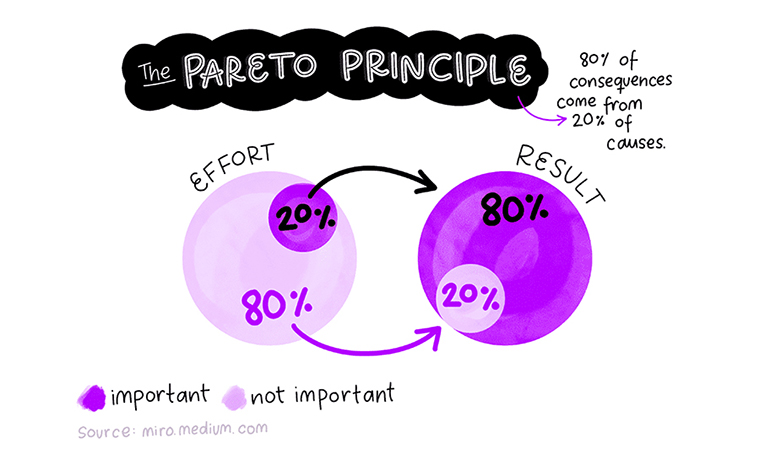In the hustle and bustle of today’s fast-paced world, productivity often seems like an elusive goal. The never-ending to-do list, the constant pressure to perform, and the overwhelming sense of where to begin can leave even the most diligent workers feeling lost. This is where the Pareto Principle, often referred to as the 80/20 Rule, steps in as your guiding light.
The Pareto Principle is a potent concept employed across diverse industries and businesses to identify high-impact tasks that yield maximum results. By embracing this principle, you can not only enhance your productivity but also elevate your profitability. In this comprehensive guide, we’ll delve into the essence of the Pareto Principle, its origins, and most importantly, how you can apply it to your personal and professional life.
Understanding the Origins of the Pareto Principle
The Pareto Principle, popularized as the 80/20 Rule, traces its roots back to the early 1900s when Vilfredo Pareto, an Italian economist, made a fascinating observation. Pareto noticed that 80% of Italy’s land was owned by a mere 20% of the population. This intriguing phenomenon extended beyond wealth distribution; Pareto also observed it in his garden, where 20% of the pea plants generated 80% of the crop yield.
The core idea behind the Pareto Principle is this: a significant majority of outcomes (approximately 80%) typically stem from a relatively small portion of inputs (roughly 20%). While it’s crucial to note that the 80/20 Rule isn’t a precise mathematical formula, it serves as a guiding principle that highlights the disproportionate relationship between effort and results. In essence, it encourages you to focus your time, energy, and resources where they will have the most substantial impact.
Applying the Pareto Principle in Various Domains
The beauty of the Pareto Principle lies in its versatility. It can be wielded as a powerful tool in numerous aspects of life and work. Here are some practical applications:
1. Business Profits and Sales: In the business realm, the Pareto Principle reveals that approximately 80% of your profits often originate from just 20% of your customers or sales. By identifying and nurturing your high-value clients, you can significantly boost your bottom line.
2. Marketing and Campaigns: Marketers frequently encounter the 80/20 Rule when analyzing campaign effectiveness. It might become evident that 20% of your marketing efforts generate 80% of your results. Concentrating resources on these high-impact strategies can optimize your marketing ROI.
3. Time Management and Productivity: On a personal level, the Pareto Principle can guide your time management efforts. It suggests that 20% of your efforts contribute to 80% of your results. By pinpointing these vital tasks, you can streamline your workflow and skyrocket your productivity.
How to Harness the Power of the 80/20 Rule
Now that we’ve explored the concept and its applications, let’s dive into practical strategies for leveraging the Pareto Principle to your advantage.
1. Task Prioritization: When faced with a daunting to-do list, use the Pareto Principle to identify the 20% of tasks that will yield 80% of the desired outcomes. Focus your energy and attention on these high-impact tasks, ensuring that they receive the priority they deserve.
2. Project Management: When overseeing a team or project, apply the 80/20 Rule to discern the critical tasks that will drive the project’s success. Delegate these tasks to your team, allowing them to concentrate their efforts on the most significant contributors to project outcomes.
3. Decision-Making: The Pareto Principle can aid in making tough business decisions. If time or resources are limited, allocate them to the 20% of clients or projects that deliver 80% of your results, optimizing your return on investment.
4. Collaboration and Delegation: Encourage collaboration within your team by assigning high-impact tasks to team members. Emphasize that their contributions directly impact the most substantial outcomes, motivating them to excel in their roles.
The Pitfalls to Avoid
While the Pareto Principle is a powerful tool, it’s essential to navigate its potential pitfalls. Remember that the 80/20 Rule doesn’t imply working less or neglecting small tasks. Every task has its place and significance. Additionally, applying the principle to employee performance doesn’t mean disregarding the contributions of the remaining 80%. Instead, use it as a guide to allocate tasks and responsibilities effectively.
Embracing the Essence of the Pareto Principle
In conclusion, the Pareto Principle serves as a beacon of efficiency and productivity. Beyond the numbers, it embodies the philosophy that not all efforts are created equal. By channeling your resources towards tasks, clients, or projects that promise the most substantial returns, you’re more likely to amplify your profits while minimizing wasted time and energy. The 80/20 Rule isn’t just a concept; it’s a pathway to achieving more with less, a universal principle that empowers you to unlock your full potential.

